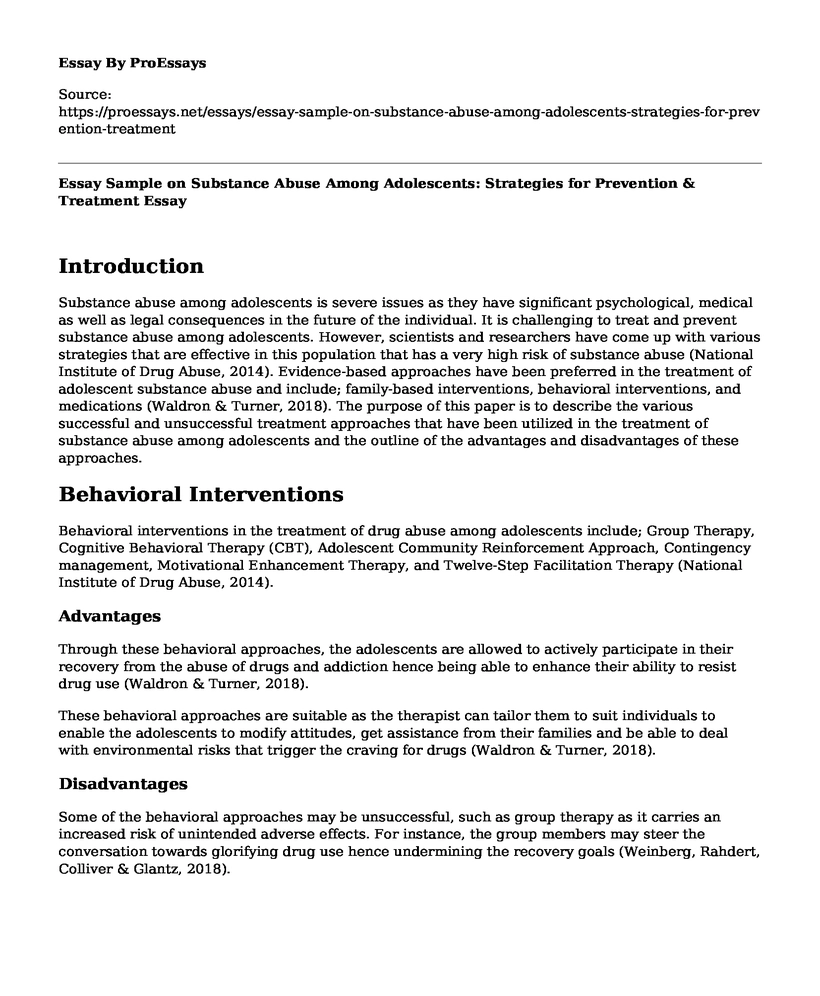Introduction
Substance abuse among adolescents is severe issues as they have significant psychological, medical as well as legal consequences in the future of the individual. It is challenging to treat and prevent substance abuse among adolescents. However, scientists and researchers have come up with various strategies that are effective in this population that has a very high risk of substance abuse (National Institute of Drug Abuse, 2014). Evidence-based approaches have been preferred in the treatment of adolescent substance abuse and include; family-based interventions, behavioral interventions, and medications (Waldron & Turner, 2018). The purpose of this paper is to describe the various successful and unsuccessful treatment approaches that have been utilized in the treatment of substance abuse among adolescents and the outline of the advantages and disadvantages of these approaches.
Behavioral Interventions
Behavioral interventions in the treatment of drug abuse among adolescents include; Group Therapy, Cognitive Behavioral Therapy (CBT), Adolescent Community Reinforcement Approach, Contingency management, Motivational Enhancement Therapy, and Twelve-Step Facilitation Therapy (National Institute of Drug Abuse, 2014).
Advantages
Through these behavioral approaches, the adolescents are allowed to actively participate in their recovery from the abuse of drugs and addiction hence being able to enhance their ability to resist drug use (Waldron & Turner, 2018).
These behavioral approaches are suitable as the therapist can tailor them to suit individuals to enable the adolescents to modify attitudes, get assistance from their families and be able to deal with environmental risks that trigger the craving for drugs (Waldron & Turner, 2018).
Disadvantages
Some of the behavioral approaches may be unsuccessful, such as group therapy as it carries an increased risk of unintended adverse effects. For instance, the group members may steer the conversation towards glorifying drug use hence undermining the recovery goals (Weinberg, Rahdert, Colliver & Glantz, 2018).
Family-Based Interventions
Family-based interventions are approaches that are used in the treatment of adolescent's substance abuse that involves engaging the family members such as parents and siblings and also peers (Weinberg et al. 2018).This method has been successful since the family is included in the recovery process.
Advantages
Family-based interventions involve a combination of various activities that are included in the treatment of adolescent substance abuse through the building of family support, together with an education that is aimed at increasing physical activity among the youth (Weinberg et al. 2018).
Another advantage is that this approach reinforces positive and desirable behaviors due to rewards and having role models from instructors or parents.
Disadvantages
Although family-based interventions have been successful in most instances, the approach is limited to situations where both the adolescent and the family members are fully committed (Weinberg et al. 2018).Therefore, it is hard to predict who will be likely to respond.
Undertreating of adolescent substance abuse through family-based interventions leads to increased risk of relapse.
Medications
Addiction medications are used in the treatment of opioids, nicotine, and alcohol abuse among adolescents. These addiction medications are effective in treating the addiction but are yet to be approved by the FDA for use in persons under 18 years (National Institute of Drug Abuse, 2014).
Advantages
The addiction medications are specific and offers pharmacological interventions; hence, substance abuse cannot be undertreated.
Disadvantages
The lack of approval of the use of addiction medications for persons under 18 years has been a challenge hence in the majority of the cases; only preliminary evidence is present for the safety and effectiveness of these medications in adolescents (Waldron & Turner, 2018).
Conclusion
The treatment of adolescent substance abuse approaches includes; family-based interventions, behavioral interventions, and medications. Each of these approaches has been designed uniquely to address specific facets of drug abuse among adolescents and its numerous adverse effects on the individual, society, and the family. Some of the approaches that have been utilized in the treatment of substance abuse among the youths have been very successful while others have failed due to numerous individual and environmental factors and each of these approaches has both advantages and disadvantages.
References
National Institute of Drug Abuse, (2014). Advancing Addiction science. Principles of Adolescent Substance Abuse Treatment. Retrieved from: https://www.drugabuse.gov/publications/principles-adolescent-substance-use-disorder-treatment-research-based-guide/principles-adolescent-substance-use-disorder-treatment
Waldron, H. B., & Turner, C. W. (2018). Evidence-based psychosocial treatments for adolescent substance abuse. Journal of Clinical Child & Adolescent Psychology, 37(1), 238-261. Retrieved from: https://www.tandfonline.com/doi/abs/10.1080/15374410701820133
Weinberg, N. Z., Rahdert, E., Colliver, J. D., & Glantz, M. D. (2018). Adolescent substance abuse: A review of the past 10 years. Journal of the American Academy of Child & Adolescent Psychiatry, 37(3), 252-261. Retrieved from:https://www.sciencedirect.com/science/article/abs/pii/S0890856709630136
Cite this page
Essay Sample on Substance Abuse Among Adolescents: Strategies for Prevention & Treatment. (2023, Jan 25). Retrieved from https://proessays.net/essays/essay-sample-on-substance-abuse-among-adolescents-strategies-for-prevention-treatment
If you are the original author of this essay and no longer wish to have it published on the ProEssays website, please click below to request its removal:
- Article Analysis Essay on Energy for Poverty Reduction
- Position of Women in the Ecclesiastical Office Paper Example
- Drug Courts Essay Example
- Essay Sample on Racism in the American Healthcare System
- Essay Example on Ancient Egypt & Mesopotamia: Male-Dominated Societies
- Essay Example on Civil Disobedience: Deliberate Refusal to Follow State Laws
- Women Empowerment: Issues and Challenges in Global South - Essay Sample







